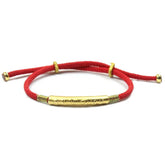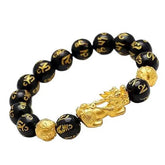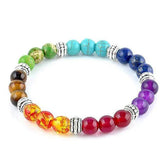(092)791-5258
Free Shipping
Feng Shui Pixiu Bracelet
Popular Products
Feng Shui Pixiu Black Obsidian Wealth Bracelet - Attract Wealth
- $20.25
$33.75- $20.25
- Unit price
- / per
7 Chakra Stone Bracelet
- $17.96
$29.93- $17.96
- Unit price
- / per
Feng Shui Pixiu Bracelet
Popular Products
Feng Shui Pixiu Black Obsidian Wealth Bracelet - Attract Wealth
- $20.25
$33.75- $20.25
- Unit price
- / per
7 Chakra Stone Bracelet
- $17.96
$29.93- $17.96
- Unit price
- / per
The Feng Shui Principles Of Wearing Pearls
Some people believe that jewelry is merely for decoration, as long as it matches the clothes and the occasion, it's considered a perfect match. However, this is a misconception; each pearl has its own Feng Shui implications.
In traditional Chinese culture, all things are categorized into five elements: metal, wood, water, fire, and earth. Everything belongs to these five elements, and the balanced energy of the five elements provides us with a "Five Element Energy Protection Field," offering protection to humanity. We need external objects to balance this Five Element energy, which not only wards off evil and calamities but also assists in balancing physical energy and magnetic fields, enhancing wisdom, and creating a bright future. It ensures a smooth path to success and a happy and fulfilling family life.
In Western folklore, pearls are considered the gemstones of the moon goddess, formed when her tears fell into oyster shells. In the eyes of ancient people, pearls had a protective role. In Indian mythology, pearls possess powerful protective powers. Pearls symbolize purity, honesty, peace, health, wealth, and beauty in the hearts of people worldwide. Due to their luster, roundness, elegance, and purity, pearls are hailed as the "queen of gemstones." The international gemstone community also considers pearls as the lucky stone for those born in June and as the commemorative stone for the thirteenth and thirtieth wedding anniversaries. Since ancient times, pearls have been loved by people, and every elegant and noble woman must have pearl jewelry.
In ancient China, people liked to use pearls as gifts during weddings to symbolize completeness and perfection. According to Chinese folklore, if a woman wears pearl earrings, it can restrain her husband's behavior, preventing him from being swayed by beautiful women and hindering his progress. Wearing a pearl ring on the index finger can bring smooth sailing and success in all endeavors, as well as blessings for safety.
In the study of Feng Shui and divination, both Qi and water are essential elements that complement each other. Water is the source of Qi, and with the rise of water, wealth flows abundantly. It is said that where there are pearls, there will be fulfillment, smooth operation, peace, and prosperity. Wearing pearls, round and lustrous, can enhance your luck at any time.
Pearls represent happiness.
By wearing pearls, you can illuminate occasional shadows in life, just like the bright sun, bringing perpetual clarity. As the birthstone for June, pearls symbolize a happy life, harmonious family relationships, and longevity. They are also the commemorative gifts for the 13th and 30th wedding anniversaries, symbolizing the harmony and longevity of marriage.
Pearls represent gentleness and charm.
They convey a demeanor of grace, elegance, purity, and sophistication. The purity, vitality, softness, and reserve contained within symbolize a woman's inner beauty. Single women wearing pearls signify inner peace, purity, elegance, and charm, exuding a special aura that can captivate the hearts of others.
Pearls symbolize nobility and elegance.
A plain women's dress or coat, when adorned with pearls, exudes extraordinary grace. Similarly, wearing pearls can enhance one's complexion and beauty. The virtues of virtue and nobility are unique to pearls, bestowing upon women the auspicious sign of prosperity and happiness, bringing them good luck and smooth sailing.
Pearls represent abundance.
The lustrous sheen and rounded contours signify wealth and harmony. Their fullness symbolizes fulfillment, prosperity, and contentment. Wearing pearls not only elevates your temperament but also attracts the joy of abundance and auspiciousness, facilitating success in all endeavors and serving as a supportive force for both fortune and wealth.
Pearls symbolize power.
Elegant and precious, pearls have been favored by royalty throughout history and admired by modern celebrities and elites. They are also a choice collectible for contemporary politicians, dignitaries, and wealthy magnates. In social interactions, presenting pearl jewelry to female clients or business partners signifies blessings for their business or official career success, making them feel respected and understood, and generating great satisfaction. One of the most famous pieces in Queen Elizabeth's jewelry collection originates from Russia, originally belonging to the Russian Duchess Vladimir, who was a princess of Mecklenburg. In 1921, Queen Mary acquired this crown, and Queen Elizabeth occasionally substitutes emeralds for the pearls set within it.
Teardrop-shaped pearls belong to the category of extremely watery objects in the Five Elements classification. They are most suitable for improving the fate of individuals deficient in water and fond of water. The teardrop shape effectively expresses this connotation, appearing beautiful, captivating, and approachable, making it highly suitable for people who favor water to wear.
The Feng Shui Principles Of Wearing Pearls
- avoid water:
Although pearls have a close relationship with water, pearl jewelry is water-resistant. Therefore, whether swimming, bathing, or exercising, do not wear pearl jewelry. If water penetrates into the pearl jewelry, it can cause the layers of pearls to separate, damaging the pearls.
- avoid being enclosed:
Pearl jewelry dislikes being enclosed. Therefore, pearl jewelry should not be stored in a sealed jewelry box for long periods. Even if not worn, pearl jewelry should be aired out regularly to prevent the pearls from turning yellow.
- avoid contamination:
Pearl jewelry is particularly sensitive to acids and alkalis. Therefore, it is recommended not to wear pearl jewelry while cooking or applying makeup. Avoid letting pearl jewelry come into contact with perfume or nail polish.
- avoid scratching:
Pearls are relatively soft, so pearl jewelry is prone to damage from hard objects. Never place pearl jewelry with sharp objects to prevent scratches.
- avoid heat:
Finally, pearl jewelry is particularly sensitive to heat. Excessive heat can accelerate the deterioration of the pearl's quality. Therefore, never expose your pearl jewelry to direct sunlight, and when storing it, wrap the pearl jewelry in a clean, soft cloth.
Precautions for Wearing Pearls:
1. Avoid Acid Erosion:
To preserve the luster and color of pearls, avoid exposing them to acids, alkalis, and chemicals such as perfumes, soaps, and hairspray. Refrain from wearing pearl jewelry while swimming or bathing. Therefore, it's advisable to put on your lovely pearls after applying makeup.
2. Keep Away from the Kitchen:
Pearls have tiny pores on their surface, making them susceptible to absorbing pollutants from the air. Pearls may absorb substances like aerosols and perfumes. Therefore, avoid wearing beautiful pearls when using hair spray and be cautious in the kitchen. Do not wear pearls while cooking, as steam and oil fumes can penetrate the pearls, causing them to yellow.
3. Avoid Direct Contact with Water:
Do not clean pearl necklaces with water. Water can enter the small pores of the pearls, making them difficult to dry and potentially causing fermentation inside, turning the pearl thread green. If you sweat a lot while wearing pearls, gently wipe them with a soft damp cloth and air dry naturally before storing them back in the jewelry box. To remedy yellowed pearls, soak them in diluted hydrochloric acid to dissolve the yellowed outer layer and restore their brilliant, captivating color. However, if the discoloration is severe, it may be challenging to reverse.
4. Allow Air Circulation:
Do not store pearls in a safe deposit box for extended periods, nor seal them in plastic bags. Pearls require fresh air circulation, so take them out every few months to let them breathe. Prolonged storage in a box can cause pearls to yellow easily.
5. Avoid Sun Exposure:
Due to their moisture content, pearls should be kept in a cool, shaded area to prevent direct sunlight exposure or placement in excessively dry environments to avoid dehydration of the pearls.
6. Prevent Scratches from Hard Objects:
Store pearl jewelry separately to avoid scratching the pearl surface with other jewelry pieces. If wearing a pearl necklace over clothing, choose garments made of soft and smooth fabrics. Rough materials may scratch your precious pearls.
7. Regular Inspection and Re-stringing Every 3 Years: Silk threads may loosen over time, so check the thread for tightness every 1 to 2 years and consider restringing pearls every 3 years. However, the frequency of restringing depends on how often the pearls are worn. Dirt entering the small holes of pearls can create friction, causing nylon threads to break, usually near the clasp where the force is applied.
8. Avoid Wearing Pearls in Summer:
During hot weather when the body sweats more, it's not advisable to wear pearl necklaces. When not in use, wipe pearls clean with a soft, slightly damp cloth and allow them to air dry for storage. Do not use any cleaning agents, expose pearls to direct sunlight or heat, store them with mothballs, or keep them in bank safety deposit boxes for extended periods.
Maintaining pearl necklace jewelry requires foresight rather than last-minute efforts. Following these guidelines is not difficult; it only requires a mindset of cherishing pearls and paying attention to maintenance, ensuring that pearls remain durable, with a lustrous surface and enduring vitality!
The Symbolism of Pearls:
1. Pearls carry the meanings of "cherish," "treasure," "true love," and "preciousness." Whether worn by a woman herself or given as a gift, they are the best blessing for women.
2. In the world of jewelry, pearls are known as the "queen of jewels" and are the queen of jewelry. At the same time, pearls also represent health, longevity, and auspiciousness, symbolizing one of the seven treasures of Buddhism.
3. In the West, pearls are revered as the birthstone of June, symbolizing health, wealth, vitality, and purity. In the East, they are hailed as the "gem of the moon," believed to strengthen friendships, enhance mental faculties, and improve memory.
4. The structure of pearls is concentric circles, symbolizing "family unity" and "complete happiness."
5. In terms of formation, pearls are crystallized through long periods of refinement by mollusks. They symbolize the greatness of motherhood, making them the best gift for mothers and embodying wishes for their well-being, happiness, and fulfillment in life.
Pearls possess the "Five Virtues."
One virtue: Tolerance
In life, the intrusion of a grain of sand stings the delicate, soft tissue of the pearl oyster, disrupting its original physiological mechanisms. When it cannot, or perhaps is unwilling to expel the grain of sand from its body, it chooses tolerance, allowing the grain of sand to become a part of itself, ultimately nurturing the growth of exquisite, beautiful pearls.
The grain of sand causes the pearl oyster pain, stimulating its pursuit and guiding it toward new goals, akin to "repaying enmity with virtue." With inherent richness, if not for pain, the most splendid aspect of its life cannot be revealed. Their greatest commonality lies in their capacity for accommodation, nurturing new life with the softest of hearts. It can be said that without accommodation, there is no birth of new life, and without accommodation, life would be dull and uneventful. Without accommodation, she would only be a plain and ordinary self, devoid of the splendor in life.
A single word, "tolerance," shapes the extraordinary lives of women.
Two virtues: Endurance
Just as women endure a ten-month pregnancy for childbirth, pearls require patient cultivation in the dim depths of the water, within the enclosed shell, day after day, year after year, secreting pearl essence. From the initial three years of nurturing the pearl oyster to the at least two years of pearl growth, enduring pain and loneliness for up to five years is necessary. This endurance is essential; without deep accumulation, there would be no dazzling brilliance and beauty upon emergence.
Noble qualities are acquired through tempering. Accumulating experience, adhering to beliefs, enduring hardships—these build pearls!
Three virtues: Cultivation
Like women, pearls spend their entire lives cultivating their character and appearance. All external manifestations are the results of inner cultivation. Not only are they outwardly elegant and beautiful, but their composition also provides factors for health and beauty. They serve not only as jewelry to enhance radiance but also as health and beauty products. Cultivation involves extracting the essence of nature, forming 18 amino acids and over 20 trace elements, with rich content and a proportionate structure deemed marvelous by ancient medical practitioners, known as "ingesting for longevity."
Four virtues: Wholeness
Women navigate life with roundedness and restraint, harboring a deep love for life. Formed by the accumulation of concentric circles, pearls are smooth and complete. The formation of a single pearl may require thousands or even tens of thousands of layers of pearl essence, tightly fused yet seamless. Throughout their growth, they maintain a round shape, pursuing constancy. Constantly seeking the formation of a perfect circle is because they have a core, growing concentrically, which leads to completion.
Five virtues: Moisture
Women, like pearls, are beautiful yet humble. They lack the dazzling brilliance of diamonds and the flamboyance of gold, instead exuding a restrained and understated elegance. Their external appearance is soft and moist, yet their internal quality is extremely hard, belonging to organic matter, contrasting with the hardness of inorganic substances like diamonds. Dwelling in the depths of extreme darkness, nurtured by water and incubated within living organisms, they absorb the essence of the sea and draw upon the vitality of the sun and moon, thus achieving a moist demeanor. When viewed in natural sunlight, they faintly shimmer with iridescent colors, making pearl luster the most elegant and noble hue.
- Choosing a selection results in a full page refresh.






